fuel KIA RIO 2017 Owners Manual
[x] Cancel search | Manufacturer: KIA, Model Year: 2017, Model line: RIO, Model: KIA RIO 2017Pages: 449, PDF Size: 14.88 MB
Page 4 of 449
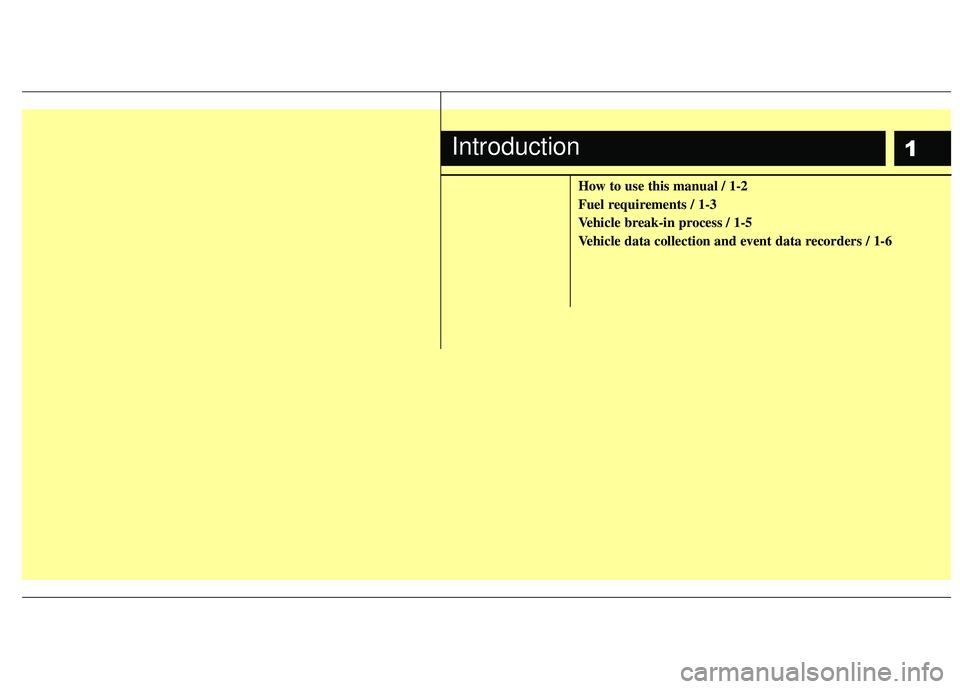
1
How to use this manual / 1-2
Fuel requirements / 1-3
Vehicle break-in process / 1-5
Vehicle data collection and event data recorders / 1-6
Introduction
Page 6 of 449

13
Introduction
Your new Kia vehicle is designed to use
only unleaded fuel having a pump octane
number ((R+M)/2) of 87 (Research
Octane Number 91) or higher. (Do not
use methanol blended fuels)
Your new vehicle is designed to obtain
maximum performance with UNLEADED
FUEL, as well as minimize exhaust emis-
sions and spark plug fouling.
✽ ✽
NOTICE
Tighten the cap until it clicks one time,
otherwise the fuel cap open warning
indicator will illuminate.
Gasoline containing alcohol and
methanol
Gasohol, a mixture of gasoline and
ethanol (also known as grain alcohol),
and gasoline or gasohol containing
methanol (also known as wood alcohol)
are being marketed along with or instead
of leaded or unleaded gasoline.
Pursuant to EPA regulations, ethanol
may be used in your vehicle. Do not use
gasohol containing more than 15%
ethanol, and do not use gasoline or
gasohol containing any methanol.
Ethanol provides less energy than gaso-
line and it attracts water, and it is thus
likely to reduce your fuel efficiency and
could lower your MPG results. Methanol
may cause drivability problems and dam-
age to the fuel system, engine control
system and emission control system.
Discontinue using gasohol of any kind if
drivability problems occur. Vehicle dam-
age or drivability problems may not be
covered by the manufacturer's warranty if
they result from the use of:
1. Gasoline or gasohol containing methanol.
2. Leaded fuel or leaded gasohol.
3. Gasohol containing more than 15% ethanol.
FUEL REQUIREMENTS
WARNING - Refueling
• Do not "top off" after the nozzleautomatically shuts off when
refueling.
Always check that the fuel cap is installed securely to prevent fuel
spillage in the event of an accident.
CAUTION
Never add any fuel system cleaningagents to the fuel tank other thanwhat has been specified. (Werecommand that you consult anauthorized Kia dealer for details.)
Page 7 of 449
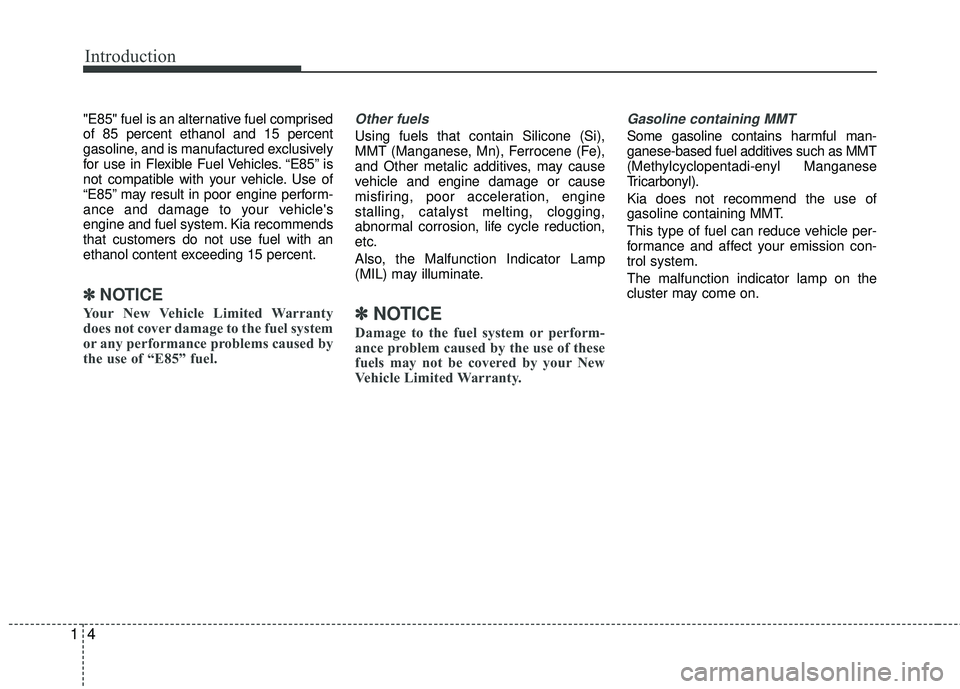
Introduction
41
"E85" fuel is an alternative fuel comprised
of 85 percent ethanol and 15 percent
gasoline, and is manufactured exclusively
for use in Flexible Fuel Vehicles. “E85” is
not compatible with your vehicle. Use of
“E85” may result in poor engine perform-
ance and damage to your vehicle's
engine and fuel system. Kia recommends
that customers do not use fuel with an
ethanol content exceeding 15 percent.
✽ ✽
NOTICE
Your New Vehicle Limited Warranty
does not cover damage to the fuel system
or any performance problems caused by
the use of “E85” fuel.
Other fuels
Using fuels that contain Silicone (Si),
MMT (Manganese, Mn), Ferrocene (Fe),
and Other metalic additives, may cause
vehicle and engine damage or cause
misfiring, poor acceleration, engine
stalling, catalyst melting, clogging,
abnormal corrosion, life cycle reduction,
etc.
Also, the Malfunction Indicator Lamp
(MIL) may illuminate.
✽ ✽
NOTICE
Damage to the fuel system or perform-
ance problem caused by the use of these
fuels may not be covered by your New
Vehicle Limited Warranty.
Gasoline containing MMT
Some gasoline contains harmful man-
ganese-based fuel additives such as MMT
(Methylcyclopentadi-enyl Manganese
Tricarbonyl).
Kia does not recommend the use of
gasoline containing MMT.
This type of fuel can reduce vehicle per-
formance and affect your emission con-
trol system.
The malfunction indicator lamp on the
cluster may come on.
Page 8 of 449
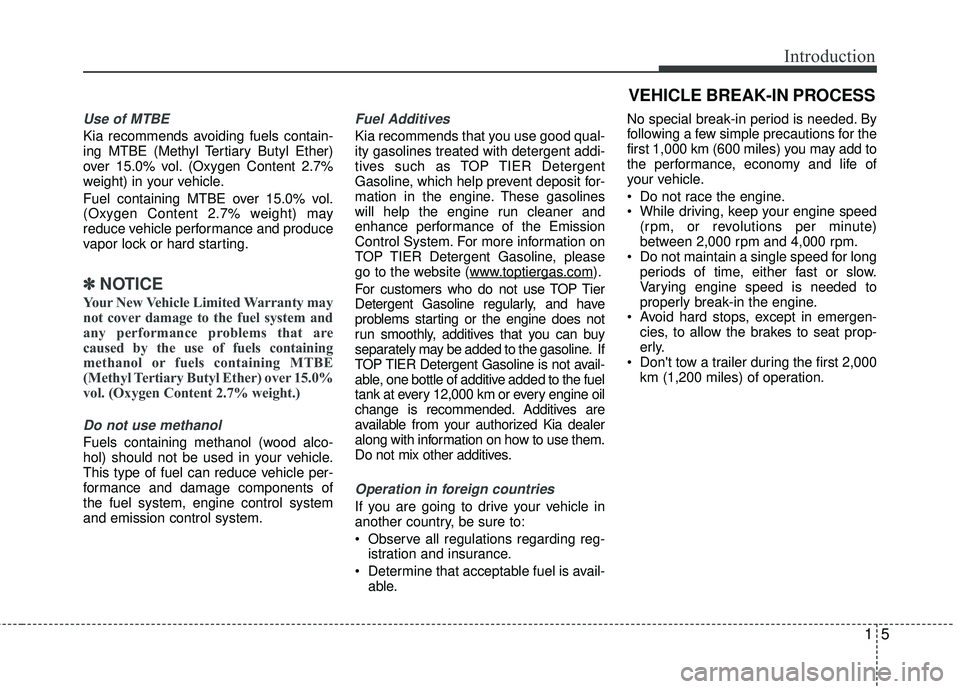
15
Introduction
Use of MTBE
Kia recommends avoiding fuels contain-
ing MTBE (Methyl Tertiary Butyl Ether)
over 15.0% vol. (Oxygen Content 2.7%
weight) in your vehicle.
Fuel containing MTBE over 15.0% vol.
(Oxygen Content 2.7% weight) may
reduce vehicle performance and produce
vapor lock or hard starting.
✽ ✽
NOTICE
Your New Vehicle Limited Warranty may
not cover damage to the fuel system and
any performance problems that are
caused by the use of fuels containing
methanol or fuels containing MTBE
(Methyl Tertiary Butyl Ether) over 15.0%
vol. (Oxygen Content 2.7% weight.)
Do not use methanol
Fuels containing methanol (wood alco-
hol) should not be used in your vehicle.
This type of fuel can reduce vehicle per-
formance and damage components of
the fuel system, engine control system
and emission control system.
Fuel Additives
Kia recommends that you use good qual-
ity gasolines treated with detergent addi-
tives such as TOP TIER Detergent
Gasoline, which help prevent deposit for-
mation in the engine. These gasolines
will help the engine run cleaner and
enhance performance of the Emission
Control System. For more information on
TOP TIER Detergent Gasoline, please
go to the website (www
.toptiergas.com).
For customers who do not use TOP Tier
Detergent Gasoline regularly, and have
problems starting or the engine does not
run smoothly, additives that you can buy
separately may be added to the gasoline. If
TOP TIER Detergent Gasoline is not avail-
able, one bottle of additive added to the fuel
tank at every 12,000 km or every engine oil
change is recommended. Additives are
available from your authorized Kia dealer
along with information on how to use them.
Do not mix other additives.
Operation in foreign countries
If you are going to drive your vehicle in
another country, be sure to:
Observe all regulations regarding reg- istration and insurance.
Determine that acceptable fuel is avail- able. No special break-in period is needed. By
following a few simple precautions for the
first 1,000 km (600 miles) you may add to
the performance, economy and life of
your vehicle.
Do not race the engine.
While driving, keep your engine speed
(rpm, or revolutions per minute)
between 2,000 rpm and 4,000 rpm.
Do not maintain a single speed for long periods of time, either fast or slow.
Varying engine speed is needed to
properly break-in the engine.
Avoid hard stops, except in emergen- cies, to allow the brakes to seat prop-
erly.
Don't tow a trailer during the first 2,000 km (1,200 miles) of operation.
VEHICLE BREAK-IN PROCESS
Page 12 of 449
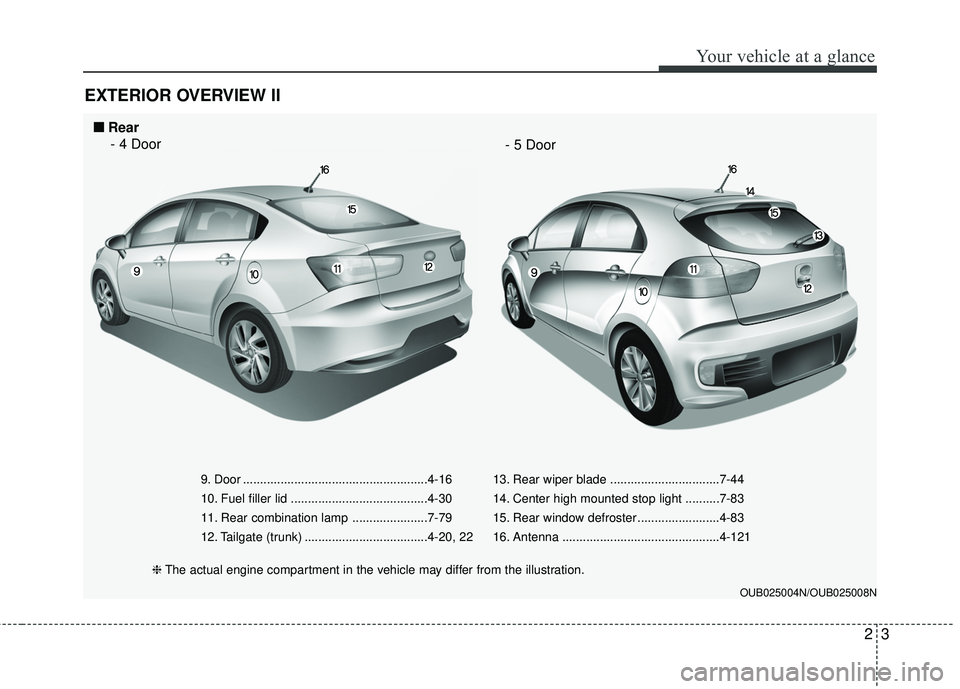
23
Your vehicle at a glance
EXTERIOR OVERVIEW II
9. Door ......................................................4-16
10. Fuel filler lid ........................................4-30
11. Rear combination lamp ......................7-79
12. Tailgate (trunk) ....................................4-20, 2213. Rear wiper blade ................................7-44
14. Center high mounted stop light ..........7-83
15. Rear window defroster ........................4-83
16. Antenna ..............................................4-121
OUB025004N/OUB025008N
■ ■
Rear
- 4 Door
❈ The actual engine compartment in the vehicle may differ from the illustration.
- 5 Door
Page 13 of 449
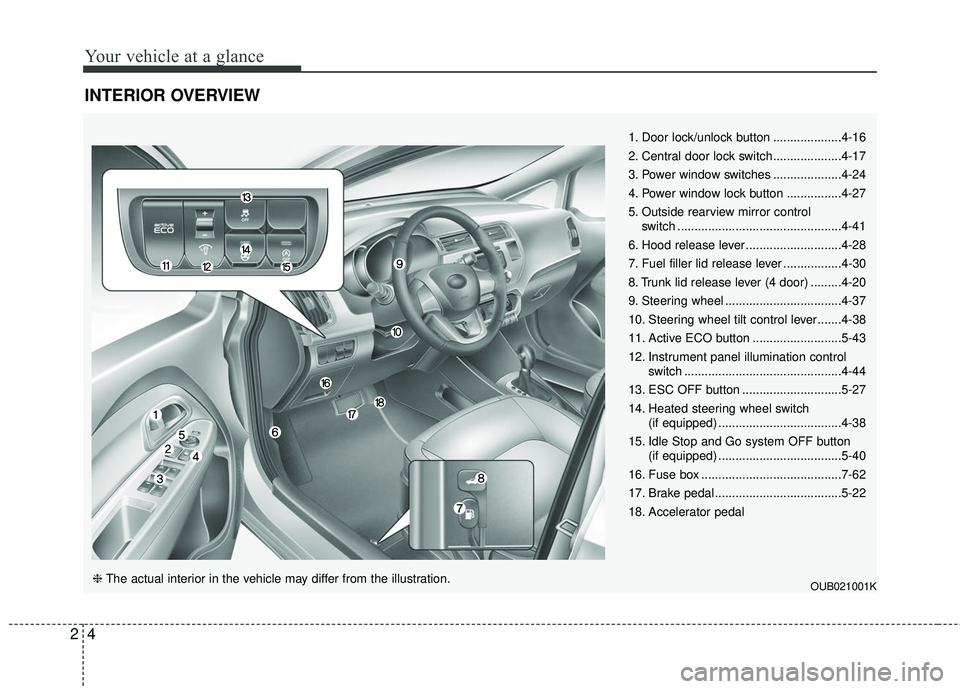
Your vehicle at a glance
42
INTERIOR OVERVIEW
OUB021001K
1. Door lock/unlock button ....................4-16
2. Central door lock switch....................4-17
3. Power window switches ....................4-24
4. Power window lock button ................4-27
5. Outside rearview mirror control switch ................................................4-41
6. Hood release lever ............................4-28
7. Fuel filler lid release lever .................4-30
8. Trunk lid release lever (4 door) .........4-20
9. Steering wheel ..................................4-37
10. Steering wheel tilt control lever.......4-38
11. Active ECO button ..........................5-43
12. Instrument panel illumination control switch ..............................................4-44
13. ESC OFF button .............................5-27
14. Heated steering wheel switch (if equipped) ....................................4-38
15. Idle Stop and Go system OFF button (if equipped) ....................................5-40
16. Fuse box .........................................7-62
17. Brake pedal .....................................5-22
18. Accelerator pedal
❈ The actual interior in the vehicle may differ from the illustration.
Page 72 of 449
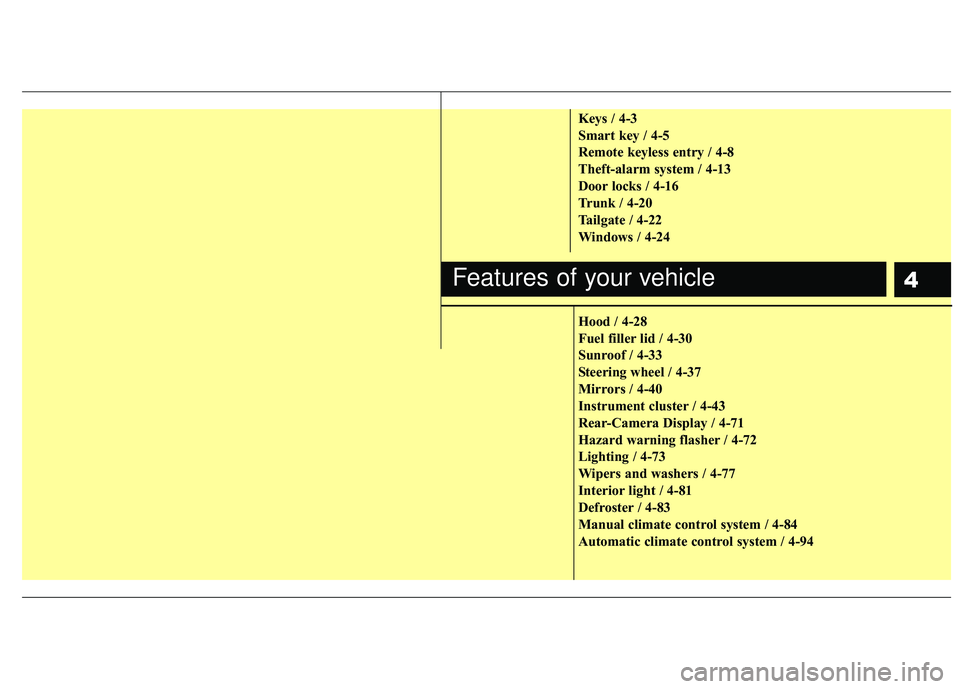
4
Keys / 4-3
Smart key / 4-5
Remote keyless entry / 4-8
Theft-alarm system / 4-13
Door locks / 4-16
Trunk / 4-20
Tailgate / 4-22
Windows / 4-24
Hood / 4-28
Fuel filler lid / 4-30
Sunroof / 4-33
Steering wheel / 4-37
Mirrors / 4-40
Instrument cluster / 4-43
Rear-Camera Display / 4-71
Hazard warning flasher / 4-72
Lighting / 4-73
Wipers and washers / 4-77
Interior light / 4-81
Defroster / 4-83
Manual climate control system / 4-84
Automatic climate control system / 4-94
Features of your vehicle
Page 101 of 449
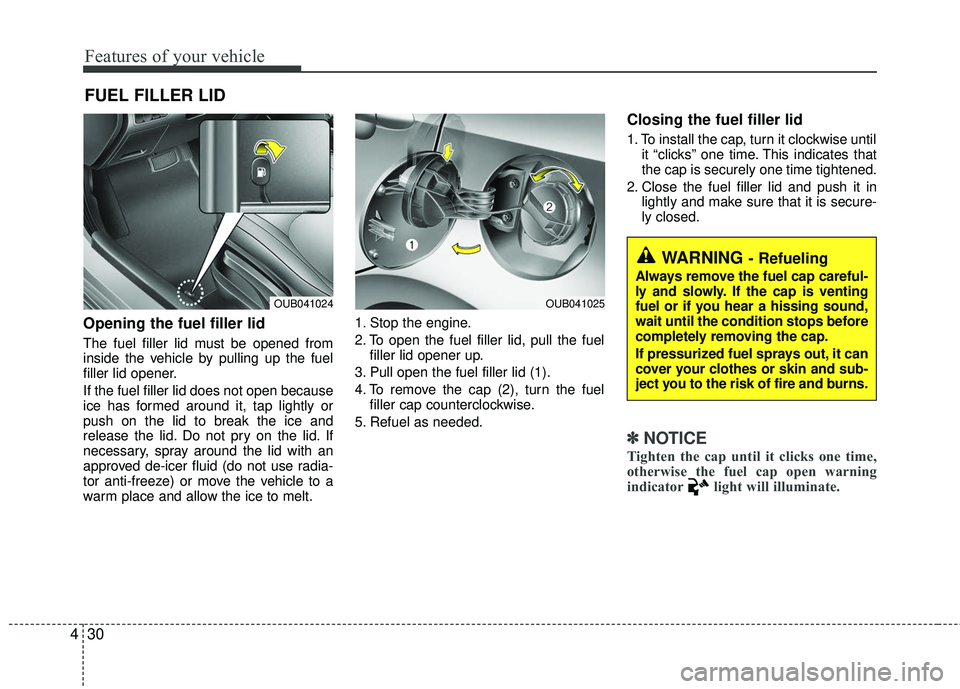
Features of your vehicle
30
4
Opening the fuel filler lid
The fuel filler lid must be opened from
inside the vehicle by pulling up the fuel
filler lid opener.
If the fuel filler lid does not open because
ice has formed around it, tap lightly or
push on the lid to break the ice and
release the lid. Do not pry on the lid. If
necessary, spray around the lid with an
approved de-icer fluid (do not use radia-
tor anti-freeze) or move the vehicle to a
warm place and allow the ice to melt. 1. Stop the engine.
2. To open the fuel filler lid, pull the fuel
filler lid opener up.
3. Pull open the fuel filler lid (1).
4. To remove the cap (2), turn the fuel filler cap counterclockwise.
5. Refuel as needed.
Closing the fuel filler lid
1. To install the cap, turn it clockwise until it “clicks” one time. This indicates that
the cap is securely one time tightened.
2. Close the fuel filler lid and push it in lightly and make sure that it is secure-
ly closed.
✽ ✽
NOTICE
Tighten the cap until it clicks one time,
otherwise the fuel cap open warning
indicator light will illuminate.
FUEL FILLER LID
WARNING - Refueling
Always remove the fuel cap careful-
ly and slowly. If the cap is venting
fuel or if you hear a hissing sound,
wait until the condition stops before
completely removing the cap.
If pressurized fuel sprays out, it can
cover your clothes or skin and sub-
ject you to the risk of fire and burns.
OUB041024OUB041025
Page 102 of 449

431
Features of your vehicle
Always check that the fuel cap is installed
securely to prevent fuel spillage in the
event of an accident.
WARNING - Fire/explosionrisk
Read and follow all warnings posted
at the gas station facility. Failure to
follow all warnings will result in
severe personal injury, severe burns
or death due to fire or explosion.
WARNING - Cell phonefires
Do not use cellular phones while
refueling. Electric current and/or
electronic interference from cellu-
lar phones can potentially ignite
fuel vapors causing a fire.
WARNING - Portable fuelcontainer
When using an approved portable
fuel container, be sure to place the
container on the ground prior to
refueling. Static electricity dis-
charge from the container can
ignite fuel vapors causing a fire.
Once refueling has begun, contact
with the vehicle should be main-
tained until the filling is complete.
Use only approved portable plastic
fuel containers designed to carry
and store gasoline.
WARNING - Static electricity
Before touching the fuel nozzle,
you should eliminate potentially
dangerous static electricity dis-
charge by touching another metal
part of the vehicle, a safe dis-
tance away from the fuel filler
neck, nozzle, or other gas source.
Do not get back into a vehicle once you have begun refueling since
you can generate static electricity
by touching, rubbing or sliding
against any item or fabric (poly-
ester, satin, nylon, etc.) capable of
producing static electricity. Static
electricity discharge can ignite
fuel vapors resulting in rapid burn-
ing. If you must re-enter the vehi-
cle, you should once again elimi-
nate potentially dangerous static
electricity discharge by touching a
metal part of the vehicle, away
from the fuel filler neck, nozzle or
other gasoline source.
Page 103 of 449
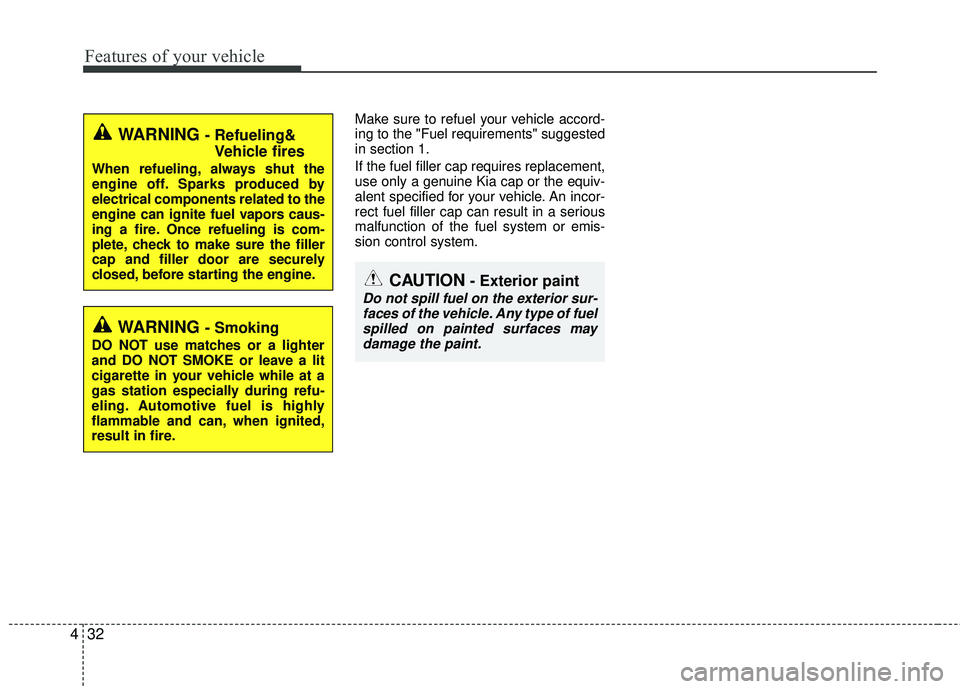
Features of your vehicle
32
4
Make sure to refuel your vehicle accord-
ing to the "Fuel requirements" suggested
in section 1.
If the fuel filler cap requires replacement,
use only a genuine Kia cap or the equiv-
alent specified for your vehicle. An incor-
rect fuel filler cap can result in a serious
malfunction of the fuel system or emis-
sion control system.
CAUTION- Exterior paint
Do not spill fuel on the exterior sur-
faces of the vehicle. Any type of fuelspilled on painted surfaces maydamage the paint.
WARNING - Refueling& Vehicle fires
When refueling, always shut the
engine off. Sparks produced by
electrical components related to the
engine can ignite fuel vapors caus-
ing a fire. Once refueling is com-
plete, check to make sure the filler
cap and filler door are securely
closed, before starting the engine.
WARNING - Smoking
DO NOT use matches or a lighter
and DO NOT SMOKE or leave a lit
cigarette in your vehicle while at a
gas station especially during refu-
eling. Automotive fuel is highly
flammable and can, when ignited,
result in fire.